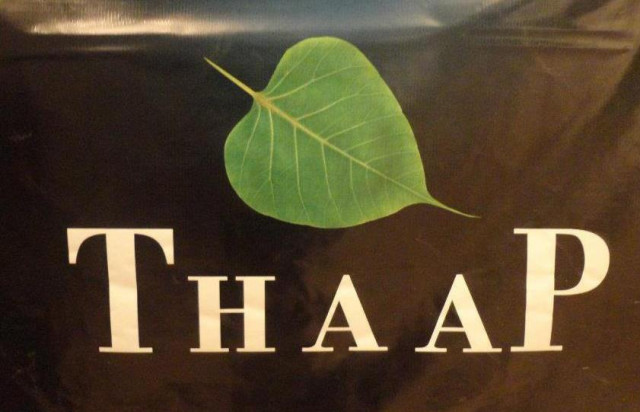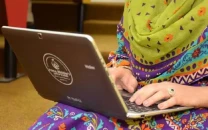THAAP conference: ‘Common sense must trump our differences’
Parks should not only provide leisure but also education, says Dr Ali Akbar Husain.

Academics and architects deliberated over the history and culture of the Punjab on the third day of the conference. PHOTO: facebook.com/Thaap
Discussions on communal harmony in the sub-continent, traditional crafts of phulkari and bagh, significance of water in the preservation of culture and a discourse on public parks and gardens engaged the audience on Sunday at the Trust for History, Art and Architecture Pakistan’s office in Lahore.
Academics and architects deliberated over the history and culture of the Punjab on the third day of the conference.
Professor Rajmohan Gandhi, historian and research professor at the Centre for South Asian and Middle Eastern Studies, University of Illinois, spoke about how sufism focused on the commonalities between religious groups in the sub-continent. In his paper, Clash vs Common Sense, Dr Gandhi said that there was a continuous dialectic between, what he termed, ‘clash’ and ‘common sense’ that shaped the culture of the Punjab. The clash focused on differences, while the common sense - used by most of the sufis - focused on commonalities. The sufis, he said, had convinced a vast majority of the population that humanity was a common denominator.

Dr Gandhi narrated anecdotes depicting communal harmony among people during periods of persecution of various religious groups in the subcontinent. He said just as there was a long tradition of clashes, there was a rich tradition of inter-religious solidarity, especially during trying times.
He said the triumph of humanity and common sense over clashes was important to heal the Punjab. Responding to a query regarding the lessons drawn from the Partition, Dr Gandhi said that history alone was not enough to bring about a transformation. “History alone will not provide a strategy or a backbone to help us learn lessons,” he said.
Parks for education
Public parks were not just intended to provide leisure but also education, Dr Ali Akbar Husain, head of the architecture department at the Indus Valley School Karachi, said. His paper, Revisiting Our Roots: A Stroll in the Lawrence Gardens, discuses the use of arboretums - gardens having a collection of trees designed in a way that helped people identify various trees.
One of the first botanical gardens, Dr Husain said, was cultivated in Calcutta. Most of the gardens in the Mughal era focused primarily on leisure, he said, the Colonial gardens focused both on leisure and scientific education.
He said after Partition, what with the establishment of the Parks and Horticulture Authorities, there was still much to be done. The lack of consistency and “ugly” labelling of trees marred public parks in the Punjab. “Botanical gardens have lost their purpose because people fail to understand their purpose. Ignoring gardens will only encourage anti-social behaviour in our society,” he said.
Tentage in Lahore
Tentage in Lahore: Continuation of the Mughal’s Tradition explored the ‘tent culture’ in the Mughal period. Beenish Tahir, head of the textile design department at the Punjab University, narrated the history of tents used during the reign of emperors Akbar, Jehangir and Humayun. She spoke about the materials [brocade and velvet] and decorative techniques [block printing] used for tents during the Mughal era. Red was used to distinguish the tents housing the royal family, she said.
Women and embroidery
Professor Jasleen Dhamija’s paper, Phulkari and Bagh: The Punjabi Women’s Creativity, explored the relationship between art and people. The paper was read out by THAAP joint secretary Aabidah Ali. The paper described the creativity of Punjabi women as boundless and free flowing. Creative expression in the Punjab was inspired by various invasions, the paper suggested. Girls were taught simple embroidery at a young age that gradually became more complex as they grew up. From wrapping newborn babies in embroidered cloth, using it as covering during adolescence to adorning themselves when they wed, Dhamija wrote, the craft was deeply rooted in the culture of Punjab.
River and Culture
River and Culture: A Bonding, a paper by Dr Amit Ranjan, explored how the “elixir of life” has transformed cultural ideas and life in the Punjab. Dr Ranjan said water not only contributed to agriculture but also to industrial revolutions. Rivers should be considered embedded entities and not just water bodies, he said. Several religious rituals involved water, he said, River Ganges was revered because of its religious symbolism. “Hindus relate the river with purity,” he said. “We must save our rivers to preserve culture.”
Published in The Express Tribune, December 9th, 2013.









1733130350-0/Untitled-design-(76)1733130350-0-208x130.webp)









COMMENTS
Comments are moderated and generally will be posted if they are on-topic and not abusive.
For more information, please see our Comments FAQ